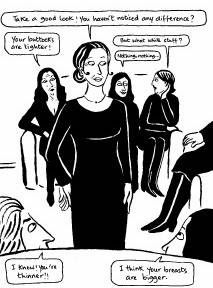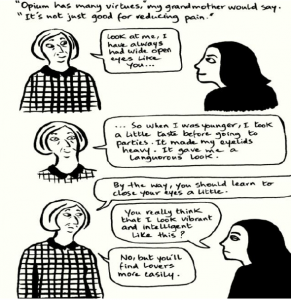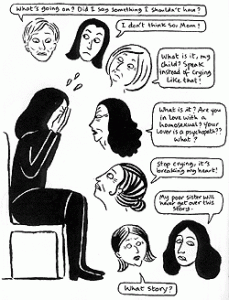
Embroideries and the Layering of Women’s Relationships Through Comics
I decided to read Embroideries by Marjane Satrapi because, besides loving her Persepolis book, I am extremely interested in the relationships women have with each other. The premise of the book is simple: after having lunch, the men in the house take naps and the women – Marjane, her mother, her grandmother and a few neighbors – get together to drink some tea and share life stories.
Perhaps the premise seems very mundane, but I have always thought that the most important stories are told when women feel safe enough in each other to share them. It probably sounds cliché, but when I have a group of girlfriends at my house and we share our latest news, it feels like building a village of trust. However, one thing I think Satrapi does very well in Embroideries is demystify how fuzzy and warm these environments are usually portrayed as: she layers the women’s relationships with each other with judgement, opinion and minor conflicts. I think there’s a danger in representing women – even feminist women – as a monolith population that always agrees with each other.
Yes, spaces like the one Satrapi illustrates in Embroideries are incredibly important but often, when talking and portraying female friendships, media either sticks to catty stereotypes or exacerbates sisterhood to an unrealistic ideal. Being a woman doesn’t automatically mean I will agree with what another woman says or thinks. Satrapi portrays these relationships as layered and complex, which is definitely helped by the graphic novel format the story is told in.
Satrapi shows how these women are moved by compassion, but also curiosity. For example, when one of the women bursts into tears, the women are eager to hear her story perhaps to console her but also to know what the gossip is. Motivations are complex like that: sometimes there’s more than one emotion flaring up and here, compassion is mixed up with the need for gossip. I can only speak for myself as a woman here, but this strikes me as such an honest depiction of moments like that between women. I care about my friends and what their stories are, but there’s curiosity within those feelings too.


Embroideries also portrays other negotiations these women must deal with: virginity, arranged marriages, pre-marital sex, conservatism that comes from other women. All of these subjects are layered with different opinions from different women, showing that female friendship groups aren’t all fuzzy and warm, but are definitely open to conversation, debate and autonomy. The graphic novel format helps articulate these complexities in a way that a written book never could.












